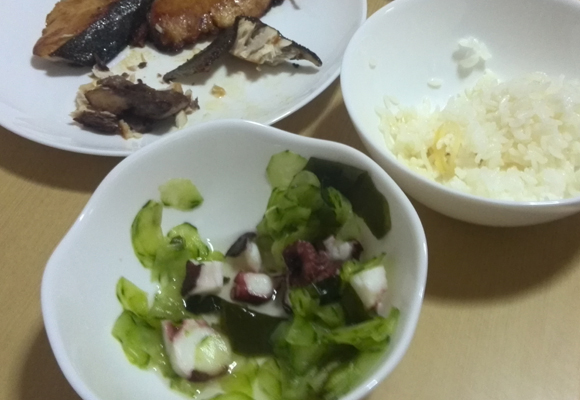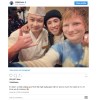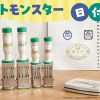
The other day I was eating at a restaurant that served their French fries with a small cup. One half was filled with ketchup and the other half mayonnaise. The presentation was quite lovely but it made me wonder. It was about the size of a pudding cup and there was no way I would be able to use all of those condiments in one sitting. What would happen to the rest of it? Would it be thrown out? Surely it wouldn’t end up being served to another customer after I’d dipped my fries and poked around in it for the majority of my meal?
My first thought was that if I didn’t bother to touch it at all, they could just stick it in the fridge to give to someone else. But would they even do that? How do they know I didn’t sneeze all over it before leaving it behind? No, if I didn’t touch it then chances are they would throw it out and it would be an even bigger waste. At a loss, I ended up having my necessary share and leave the rest to an unknown fate.
Later on, checking around the internet yielded little in the way of a solid answer. Most food and restaurant oriented websites had articles which didn’t give many specific examples but basically said that it’d be naive to assume many restaurants don’t do at least a little food recycling.
Forums were also mixed with users telling tales of people’s unused bits of beef getting added to chili and uneaten complimentary pieces of bread ending up on other tables. Others maintain that the cost-saving simply wouldn’t be worth the risk of customers becoming ill and suing or getting shut down by the health department.
There was such a case in Japan a few years back where the maker of Akafuku (mochi filled with sweet bean paste famous in Ise City) got shut down for a year after it came to light they were reusing their unsold bean paste filling.
While there’s certainly an uncomfortable feeling when it comes to reusing certain foods, it can’t all be bad… Can it? Surprisingly, according to Ameba News, South Korean law makes certain allowances for some foods to be reused.
– Uncooked foods that maintain their original form such as tomatoes, raw garlic, and lettuce
– Uncracked quail eggs and unpeeled ingredients like bananas and grapes which maintain their original skin and didn’t come in contact with other substances.
– Food in a container with a lid such as kimchi and Kkakdugi whose amount was decreased having been ingested by the customer
It’s a politically ballsy move for South Korea to have actually outlined certain foods deemed legal to reuse. A lot of people are undoubtedly turned off a the prospect of getting double-dipped kkakdugi. It’s hard to say how many (if any) restaurants actually act on those exemptions, though.
Still, maybe by enacting such measures around the world certain foods could be openly recognized as “reusable.” Then diners everywhere would know to be more careful around them, thus making them healthy to share and reducing the amount of food wasted in the world.
Yeah, I know… But it’s a nice thought, isn’t it?
Source: Ameba News (Japanese)
Image: RocketNews24

 Cool and fun paper craft from the makers of Akafuku — one of Japan’s favorite sweets!
Cool and fun paper craft from the makers of Akafuku — one of Japan’s favorite sweets! Common ramen ingredient found highly effective at clearing up radioactive contamination
Common ramen ingredient found highly effective at clearing up radioactive contamination Fishin’ for crawdads in Tokyo: A tale of friendship
Fishin’ for crawdads in Tokyo: A tale of friendship Six Japanese foods you won’t want to miss trying in Ise
Six Japanese foods you won’t want to miss trying in Ise Vending machine in Yokohama begins selling bakery bread set to be thrown away, reduces food waste
Vending machine in Yokohama begins selling bakery bread set to be thrown away, reduces food waste McDonald’s new Happy Meals offer up cute and practical Sanrio lifestyle goods
McDonald’s new Happy Meals offer up cute and practical Sanrio lifestyle goods All-you-can-drink Starbucks and amazing views part of Tokyo’s new 170 meter-high sky lounge
All-you-can-drink Starbucks and amazing views part of Tokyo’s new 170 meter-high sky lounge Beautiful Sailor Moon manhole cover coasters being given out for free by Tokyo tourist center
Beautiful Sailor Moon manhole cover coasters being given out for free by Tokyo tourist center Studio Ghibli glasses cases let anime characters keep an eye on your spectacles
Studio Ghibli glasses cases let anime characters keep an eye on your spectacles Super Nintendo World expansion gets delayed for several months at Universal Studios Japan
Super Nintendo World expansion gets delayed for several months at Universal Studios Japan Arrest proves a common Japanese saying about apologies and police
Arrest proves a common Japanese saying about apologies and police Hamster abandoned at Tokyo ramen restaurant gets new home
Hamster abandoned at Tokyo ramen restaurant gets new home Ed Sheeran’s bromance with One Ok Rock frontman warms the hearts of fans around the world
Ed Sheeran’s bromance with One Ok Rock frontman warms the hearts of fans around the world New Pokémon blankets are part plushie cushion, part fluffy wrap, and all adorable【Photos】
New Pokémon blankets are part plushie cushion, part fluffy wrap, and all adorable【Photos】 Spruce up your office with Pikachu date stamps in various sizes and styles
Spruce up your office with Pikachu date stamps in various sizes and styles Disney princesses get official manga makeovers for Manga Princess Cafe opening in Tokyo
Disney princesses get official manga makeovers for Manga Princess Cafe opening in Tokyo More foreign tourists than ever before in history visited Japan last month
More foreign tourists than ever before in history visited Japan last month Starbucks reopens at Shibuya Scramble Crossing with new look and design concept
Starbucks reopens at Shibuya Scramble Crossing with new look and design concept Beautiful new Final Fantasy T-shirt collection on the way from Uniqlo【Photos】
Beautiful new Final Fantasy T-shirt collection on the way from Uniqlo【Photos】 Is the new Shinkansen Train Desk ticket worth it?
Is the new Shinkansen Train Desk ticket worth it? Foreign English teachers in Japan pick their favorite Japanese-language phrases【Survey】
Foreign English teachers in Japan pick their favorite Japanese-language phrases【Survey】 Japanese convenience store packs a whole bento into an onigiri rice ball
Japanese convenience store packs a whole bento into an onigiri rice ball We try out “Chan Ramen”, an underground type of ramen popular in the ramen community
We try out “Chan Ramen”, an underground type of ramen popular in the ramen community Studio Ghibli releases Kiki’s Delivery Service chocolate cake pouches in Japan
Studio Ghibli releases Kiki’s Delivery Service chocolate cake pouches in Japan Japan’s bone-breaking and record-breaking roller coaster is permanently shutting down
Japan’s bone-breaking and record-breaking roller coaster is permanently shutting down New definition of “Japanese whiskey” goes into effect to prevent fakes from fooling overseas buyers
New definition of “Japanese whiskey” goes into effect to prevent fakes from fooling overseas buyers Our Japanese reporter visits Costco in the U.S., finds super American and very Japanese things
Our Japanese reporter visits Costco in the U.S., finds super American and very Japanese things Studio Ghibli unveils Mother’s Day gift set that captures the love in My Neighbour Totoro
Studio Ghibli unveils Mother’s Day gift set that captures the love in My Neighbour Totoro Foreign passenger shoves conductor on one of the last full runs for Japan’s Thunderbird train
Foreign passenger shoves conductor on one of the last full runs for Japan’s Thunderbird train Domino’s Japan now sells…pizza ears?
Domino’s Japan now sells…pizza ears? New Japanese KitKat flavour stars Sanrio characters, including Hello Kitty
New Japanese KitKat flavour stars Sanrio characters, including Hello Kitty Kyoto creates new for-tourist buses to address overtourism with higher prices, faster rides
Kyoto creates new for-tourist buses to address overtourism with higher prices, faster rides Sales of Japan’s most convenient train ticket/shopping payment cards suspended indefinitely
Sales of Japan’s most convenient train ticket/shopping payment cards suspended indefinitely Sold-out Studio Ghibli desktop humidifiers are back so Totoro can help you through the dry season
Sold-out Studio Ghibli desktop humidifiers are back so Totoro can help you through the dry season Japanese government to make first change to romanization spelling rules since the 1950s
Japanese government to make first change to romanization spelling rules since the 1950s Ghibli founders Toshio Suzuki and Hayao Miyazaki contribute to Japanese whisky Totoro label design
Ghibli founders Toshio Suzuki and Hayao Miyazaki contribute to Japanese whisky Totoro label design Doraemon found buried at sea as scene from 1993 anime becomes real life【Photos】
Doraemon found buried at sea as scene from 1993 anime becomes real life【Photos】 Tokyo’s most famous Starbucks is closed
Tokyo’s most famous Starbucks is closed One Piece characters’ nationalities revealed, but fans have mixed opinions
One Piece characters’ nationalities revealed, but fans have mixed opinions We asked a Uniqlo employee what four things we should buy and their suggestions didn’t disappoint
We asked a Uniqlo employee what four things we should buy and their suggestions didn’t disappoint Princesses, fruits, and blacksmiths: Study reveals the 30 most unusual family names in Japan
Princesses, fruits, and blacksmiths: Study reveals the 30 most unusual family names in Japan Four things you should order at rotating sushi restaurant Sushiro if you don’t eat raw fish
Four things you should order at rotating sushi restaurant Sushiro if you don’t eat raw fish Guesthouse owner arrested for slashing guest who sprinkled too much pepper on his own food
Guesthouse owner arrested for slashing guest who sprinkled too much pepper on his own food Ho ho ho! Merry fried chicken sushi appears in Japan!
Ho ho ho! Merry fried chicken sushi appears in Japan! 3 unusual gyoza creations from Tochigi Prefecture, the Japanese capital of dumplings 【Taste Test】
3 unusual gyoza creations from Tochigi Prefecture, the Japanese capital of dumplings 【Taste Test】 Health Tip: Drinking live pig’s blood may lead to worms in your brain
Health Tip: Drinking live pig’s blood may lead to worms in your brain Can our writers’ taste buds pick out the luxury kamaboko fish cake from these two?
Can our writers’ taste buds pick out the luxury kamaboko fish cake from these two? Four train stations in Tokyo installed free groundwater pumps available 24-7
Four train stations in Tokyo installed free groundwater pumps available 24-7 Cost of uneaten ehomaki sushi rolls in 2022 estimated to be over one billion yen
Cost of uneaten ehomaki sushi rolls in 2022 estimated to be over one billion yen These little-known Japanese plastic bags can be a lifesaver in times of disaster
These little-known Japanese plastic bags can be a lifesaver in times of disaster A mountain of chicken katsu awaits you at this restaurant in Osaka
A mountain of chicken katsu awaits you at this restaurant in Osaka Instant-ramen coated fried chicken appears in Tokyo, instantly makes us hungry, happy【Taste test】
Instant-ramen coated fried chicken appears in Tokyo, instantly makes us hungry, happy【Taste test】 How many do you know? 12 delicious foods in Japanese supermarkets and convenience stores
How many do you know? 12 delicious foods in Japanese supermarkets and convenience stores McDonald’s Japan’s French fry rationing extended for about another month
McDonald’s Japan’s French fry rationing extended for about another month Hugh Jackman faces entrail stew, slimy sea grapes on Japanese gameshow, doesn’t bat an eye
Hugh Jackman faces entrail stew, slimy sea grapes on Japanese gameshow, doesn’t bat an eye Unlimited kushiage skewers, stewed oden, and booze at this Tokyo restaurant for under 20 bucks
Unlimited kushiage skewers, stewed oden, and booze at this Tokyo restaurant for under 20 bucks
Leave a Reply